Review: Onskreen Fusion
Score:
62%
Version Reviewed: 2.0
Buy Link | Download / Information Link
Now, there are as many ways of reading Internet content on your mobile as there are stars in the sky (well, almost), but Onskreen have come up with something a bit different. Rather than a 'mobile web' portal or an online RSS aggregator (don't worry, Ewan's going to do a feature on these soon and explain how it all works) or a dedicated 'news grabber' application, all of which work more or less in real time, Fusion works behind the scenes, getting the bits you need in the background and presenting them more or less instantaneously on your S60 standby screen. It's certainly a nice idea and, within the boundaries of what the current download tries to do, it works well, although there are quite a few caveats that stop Fusion taking the place of the more generic mobile news systems.
But let's start at the beginning. Onskreen (we'll forgive their spelling!) are mainly pitching the whole concept of Fusion at network operators around the world, most of whom run S60-based handsets. The idea is that rather than users having to get their heads round the news systems just mentioned, the operator pre-installs Fusion, with plug-ins specific to the country and operator-focus. So, for example, in the UK, someone like Vodafone would put up information from BBC news, BBC weather, Financial Times, plus specific game/ringtone buy screens. Onskreen would then get their money from the operators, for all the customisation help and licensing involved. See the polished demo to see what I mean.
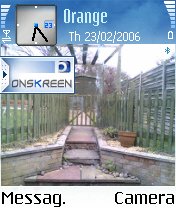
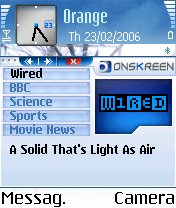
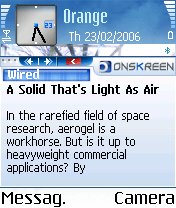
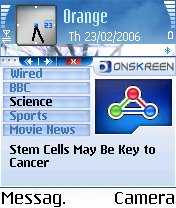
Back in the 'now', anyone (i.e. you or I) can download the software manually and have a play, hence this review. Having chosen which plug-in to assign to each of the five 'slots' (using a dedicated Fusion application/utility that appears on the main S60 Menu/launcher), you approve Fusion's request to go online and start gathering data and then sit back and wait. Every so often (around half an hour), Fusion goes off and gets the latest stories/information for your chosen plug-ins, a process that happens silently in the background so that when you next flip to your standby/idle screen, the stories in each slot are current and up to date.
Fusion's interface is well thought out and attractive. A graphic burns into your mind which plug-in/slot you're currently viewing, while left and right on the navigator choose the story you'd like to view. Press the select/navigator in and you're reading the story of your choice, or at least the first paragraph of it. A final press of select and you're parcelled off to Web, to view the story on its original site/source.
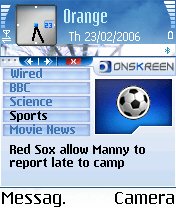


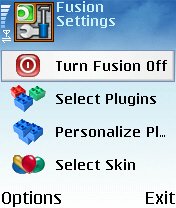
Sounds pretty cool, doesn't it? Now, some of what I'm about to say may well be rectified by operators round the world, who license Fusion and then integrate it with their chosen plug-ins properly and sensibly. But my initial use of Fusion has thrown up quite a few potential problems.
First up is the reckless abandon shown for GPRS bandwidth, characteristic of solutions coming out of America, where such things as flat rate plans exist. In normal operation, for a typical set of plug-ins, around 100K of data an hour is transferred across your network connection. While this doesn't sound astronomical in itself, do the maths. That's 2.4MB per day, or 70MB a month, which would cost you an arm and a leg on almost any non-US data tariff. It's possible, using the configuration utility, to turn Fusion on and off, but such manual intervention rather defeats the point of a background, automatic system.
This regular devouring of data is compounded hugely by unintelligent links in each plug-in. The idea is that you can link through a story first paragraph, to a web page with the full details, but when you do so you're dumped into the full, high-bandwidth version of the appropriate site. In some cases we tried, the destination page was over 500K, including images and other bloat, just for a single textual story of around 1K in length! Given that almost all popular providers have mobile-friendly versions of their sites now, I'm amazed that it's not these pages which get linked to.
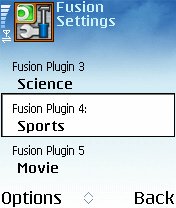
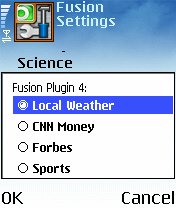

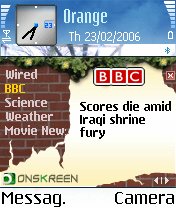
A secondary concern is that by putting the user into Web to read any kind of detail, there's a big overall hit on your smartphone's RAM. Many handsets (e.g. the 6680) are already RAM-challenged, typically running with only 2 or 3 MB free, after loading the basic PIMand messaging apps. Fusion itself needs around 1.3MB to run and Web can easily swallow up another 2 to 3MB, meaning that clicking through to a story may well lead to 'Memory full' errors and possible reboots.
Add these potential problems to the fundamental limits of the system. Yes, it's all very pretty and it's nice to have it pre-cached on your standby screen (or on a pretty good fascimile of it), but at the end of the day, it's just five channels of publically available data with a dozen or so headlines and first paras for each. Using something like Mobile NewsGrabber or BlogLines would enable you to access a vastly wider pool of information, in a lot more depth, arguably a lot more efficiently. You can't easily, as a user at least, simply add your own feeds and 'wants' into Fusion, you're limited by the small number of official (rather US-centric) plug-ins, each neatly packaged into SIS format. A little hacking with FExplorer reveals that each plug-in is, not surprisingly, a simple RSS/XML feed at heart, perhaps opening the door for custom plug-ins in the future.
But perhaps I'm being a little over critical. Onskreen don't really want people like you and I downloading Fusion in big numbers - they want the network operators, the ones with the money(!), to license Fusion and package it for their users, on their handsets and on their tariffs. In the right hands, with some carefully chosen plug-ins, linking to carefully selected source pages, the bandwidth needed could be limited, especially with a lower frequency of updates and with some kind of tie-in to the user's data tariff. In this situation, Fusion would make sense, as a low-maintenance 'no brain needed' RSS news system for the general user.
In which case consider the current Fusion download as a technology demo rather than a usable application. Which is exactly as it should be.
Reviewed by Steve Litchfield at
